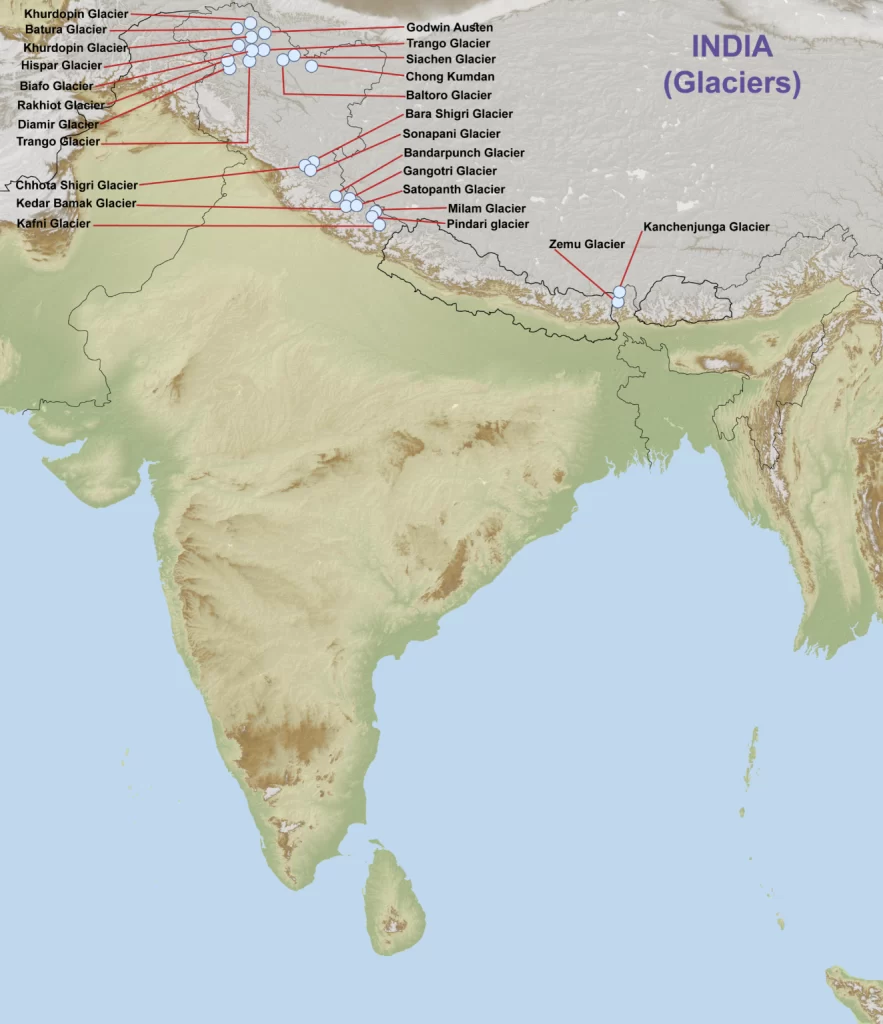CONTENTS
- The Telecommunications Bill, 2023
- Fossil Fuels and the Rapid Retreat of Glaciers
The Telecommunications Bill, 2023
Context:
The nearing enactment of the Telecommunications Bill, 2023, brings the Union government closer to its longstanding goal of consolidating regulations for wireless networks and Internet service providers.
Relevance:
GS- 2
Government Policies & Interventions
GS- 3
- Industrial Growth
- IT & Computers
Mains Question:
With reference to the recent Telecommunications Bill, 2023, discuss how it aims to regulate the telecom sector in India? Also highlight the challenges that persist in the bill and a way forward strategy to effectively deal with it. (15 Marks, 250 Words).
Telecom Sector in India:
- As per the Telecom Regulatory Authority of India (TRAI), India currently holds the position of the world’s second-largest telecommunications market, boasting an overall teledensity of 85.11% as of July 2022.
- The country is experiencing a steady increase in internet and broadband penetration, providing impetus to the Government’s Digital India initiative. Furthermore, India has recently entered the global 5G race.
Present Status of the Telecom Sector in India:
- Expansive Telecom Market: India ranks as the second-largest telecommunications market globally, boasting a subscriber base of 1.20 billion and exhibiting robust growth over the past fifteen years. Additionally, India is poised to become the world’s second-largest smartphone market by 2025.
- Contribution to Government Revenue: The telecom sector significantly contributes to the government’s non-tax revenue through spectrum auctions, one-time fees from new operators, recurring license fees, and spectrum charges. The success of the Digital India program is closely tied to the prosperity of this sector.
- Foreign Direct Investment (FDI): The telecom sector now permits 100% Foreign Direct Investment (FDI) under the automatic route.
Key Government Initiatives:
- Full Mobile Number Portability (MNP): The government has sanctioned One Nation Full Mobile Number Portability (MNP), allowing subscribers to switch their service area while retaining their mobile number.
- BharatNet: The government is actively implementing the BharatNet project, aiming to connect each of the 2.5 lakh Gram Panchayats in India through an optical fiber network. This initiative stands as the world’s largest rural connectivity project of its kind.
- Thriving 5G Era: The Government of India has recently introduced 5G, not only enhancing communication technology but also contributing to initiatives like ‘Digital India‘ and ‘Smart Cities.‘
Telecommunications Bill, 2023:
Main Idea:
The introduction of the Telecommunications Bill, 2023, in the Lok Sabha is centered on the advancement and regulation of telecommunication services and networks.
The primary objective is to streamline existing laws, keeping pace with the dynamic nature of telecommunications, with a strong focus on national security and fostering inclusive digital development.
Key Points:
- Legislative Replacement: The Telecommunications Bill, 2023, aims to replace the Indian Telegraph Act, 1885, the Indian Wireless Telegraphy Act, 1933, and the Telegraph Wires (Unlawful Possession) Act, 1950.
- Emphasis on Modernization: Recognizing the substantial transformations in telecommunication technologies and usage, the Bill proposes a contemporary legal framework tailored to the current state of the sector.
- The 46-page statute maintains existing regulatory structures while simplifying bureaucratic processes, such as license and permit applications for telecom operators.
- The digitization of licensing processes is a notable feature, and telecom operators will face a new approach to handling non-compliance with license terms.
- Moreover, they will now have access to district- and State-level authorities for permissions and dispute resolution when establishing equipment and optical fiber networks on public and private properties.
- Notably, the Bill provides relief for the satellite Internet industry, clarifying that it won’t need to bid for spectrum, aligning India with other nations. Industry bodies have welcomed the Bill for streamlining regulatory frameworks, enhancing ease of doing business, and potentially providing the regulatory stability needed for the next phase of telecom expansion.
- With over half of India’s population on the fringes of the connected world, the Bill holds the potential to improve connectivity for these marginalized areas.

Persisting Challenges:
- The broad definition of telecommunications in the Bill encompasses a variety of services, and the state’s authority over them raises concerns about privacy and surveillance. These concerns are not merely theoretical, given past accusations of state-sponsored surveillance.
- While the Bill attempts to address spamming issues, its proposed solutions necessitate additional compromises on privacy.
- The matters of surveillance reform and Internet shutdowns carry significant consequences and should not be avoided simply because they are contentious.
Way Forward:
- The government must tackle these concerns with an open mind, acknowledging the extensive powers granted by the Bill’s text.
- In the previous publicly circulated draft for consultation, responses from industry bodies and the public were not subject to scrutiny. To further assure the public of its transparent motives, the government must conduct rule-making with absolute transparency and consultation.
- This is particularly crucial as many provisions of the Act require subordinate legislation notified by the Department of Telecommunications before they take effect.
Conclusion:
The telecommunications landscape has undergone significant changes since the inception of the Telegraph Act in the 19th century. Therefore, regulations and laws for the Internet world must comprehensively address all issues arising from this digital explosion.
Fossil Fuels and the Rapid Retreat of Glaciers
Context:
The recently concluded Conference of Parties (COP28) marked a pivotal move toward ending the fossil fuel era for the preservation of humanity. Interestingly, this landmark decision was made in Dubai, the stronghold of the powerful oil-producer group Organization of the Petroleum Exporting Countries (OPEC). During a meeting with mountain countries at COP28, U.N. Secretary-General Antonio Guterres underscored the importance of safeguarding the Himalayan glaciers.
Relevance:
GS- 3
- Environmental Pollution and Degradation
- Conservation
- Water Resources
Mains Question:
There is link between fossil fuel emissions and global warming that has serious consequences for the Himalayan region. Analyse. (10 Marks, 150 Words).
More on the Dubai Consensus:
The Dubai Consensus, a significant resolution aimed at diminishing reliance on fossil fuels, was ratified during COP 28 in Dubai.
Dubai Consensus:
- Central Point: The resolution underscores the imperative shift away from fossil fuels with the goal of achieving net-zero emissions by 2050, aligning with scientific recommendations to curb the global temperature rise.
- Equitable Representation: The wording of the document signifies a compromise between developed and developing nations regarding climate action and responsibility.
- Softening of Language: Earlier drafts, featuring terms like ‘phase-out,’ were modified due to resistance from countries dependent on oil.
- Coal Utilization: The final version of the document adjusted its stance on coal, especially beneficial for countries like India, advocating for a gradual reduction rather than a swift elimination.
- Methane Emissions: The consensus introduces a focus on reducing methane emissions by 2030, recognizing its potency as a greenhouse gas.
- Natural Gas as a Transitional Energy Source: The document’s acknowledgment of natural gas as a transitional fuel may potentially favor countries that produce gas and overlook the necessity for developed nations to address the financial gap in climate adaptation.
About Glaciers:
- Glaciers are ice masses that flow under their own weight, forming in areas where snow accumulation surpasses ablation over extended periods.
- These icy formations serve as sensitive indicators of climate change and are frequently found in snowy regions.
- Spanning more than 10% of the Earth’s land surface, glaciers constitute the largest freshwater reservoir. Despite their vastness, glaciers hold only 2.1% of Earth’s total water, with the majority—97.2%—residing in the oceans and inland seas.
Himalayan Glaciers:
- The Himalayas boast approximately 15,000 glaciers, covering an expansive area of around five lakh square kilometers (comparable to India’s land area of nearly 32 lakh sq km). Within this region, an extensive 33,000 square kilometers are blanketed with snow.
- The snow line, representing the lowest perpetual snow level, varies throughout the Himalayas due to factors such as latitude, precipitation, and topography.
- Focusing on the Karakoram Range, it stands out for having the most significant glacier development among the Himalayan ranges. This range hosts some of the largest glaciers outside of the polar and sub-polar regions.
- Numerous massive glaciers adorn the southern flank of the range, with the Siachen Glacier in Nubra Valley stretching over 75 kilometers, ranking as the world’s second-largest glacier outside polar and sub-polar areas.
- The Fedchenko Glacier in the Pamirs takes the lead as the largest, measuring an impressive 77 kilometers. The Hispar Glacier, the third-largest, spans 62 kilometers and lies on a branch of the Hunza River.
- In the Pir Panjal Range, glaciers are fewer and smaller compared to the Karakoram Range. The longest among them, the Sonapani Glacier in the Lahul and Spiti region, extends for only 15 kilometers.
- Moving to the Kumaon-Garhwal region of the Himalayas, the Gangotri Glacier, the source of the sacred Ganga, takes precedence as the largest in this area.
- In Central Nepal, notable glaciers include the Zemu and Kanchenjunga glaciers, playing a significant role in the glacial landscape of the region.

Significance of Himalayan glaciers:
- The Himalaya-Hindu-Kush and Tibetan Plateau, collectively known as the Third Pole (TP), house the Earth’s largest ice mass outside the polar regions.
- Positioned at a mid-latitude location and proximate to heavily populated and industrialized regions, the TP spans five countries (India, Nepal, Bhutan, China, and Pakistan).
- Approximately 240 million people rely on glaciers and ten major rivers originating in the Himalayas, including the Indus, Ganga, and Brahmaputra.
- Another billion people downstream in eight different nations, including India, depend on glacier-fed rivers for their livelihoods.
- The snow-covered peaks of the Himalayas exhibit a high albedo, reflecting a significant portion of incoming solar radiation. This phenomenon influences local temperatures and weather patterns, and changes in snow cover due to climate change can impact this effect.
Impact of Fossil Fuels:
- The burning of fossil fuels, a major contributor to climate change, has direct implications for the Himalayan glaciers.
- Increased tourism in the Himalayan regions, extending beyond the threshold limit of glaciers, has escalated fossil fuel emissions.
- Greenhouse gases released from burning fossil fuels, such as carbon dioxide (CO2), methane (CH4), and nitrous oxide (N2O), trap heat, creating a greenhouse effect.
- Additionally, the combustion of fossil fuels produces black carbon, a particulate matter that settles on snow and ice.
- Black carbon reduces the reflective properties of snow and ice, absorbing more sunlight and emitting infrared radiation, thereby increasing temperatures.
- Higher temperatures accelerate the melting of Himalayan glaciers, causing them to retreat. Glacier retreat alters river flow patterns, impacting water availability downstream.
- As glaciers retreat, moraine-dammed lakes form, and increased meltwater adds pressure to the dam containing the lake. This heightened pressure, coupled with factors like glacier fragmentation and landslides, can trigger displacement waves in the lake, posing the risk of a Glacial Lake Outburst Flood (GLOF). GLOFs pose substantial threats to downstream communities.
Conclusion:
The Himalayan glaciers play a crucial role as indicators of global warming and climate change. They are located in India play a vital role in supplying freshwater to the northern reservoirs and rivers of the country. This underscores the critical importance of monitoring these glaciers. Preserving the Himalayas is essential for the well-being of the region’s diverse ecosystems and local communities.





